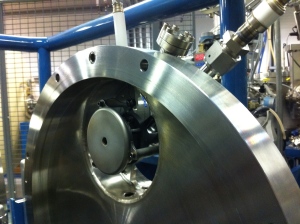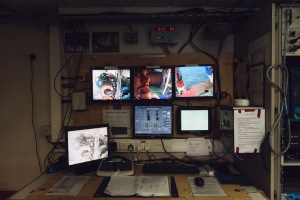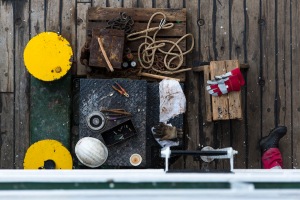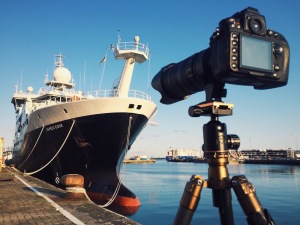To determine the rate of ice sheet retreat it is necessary to determine WHERE the ice sheet margin was WHEN. The WHERE is determined by studying landforms characteristic of glacier margins, such as moraines, erratic boulders, and sediment deposited both onshore and offshore by ice and glacial meltwater near the margins of the ice sheet. The WHEN is determined using different dating techniques depending on the material sampled. For BRITICE-CHRONO we are applying three different dating techniques, (1) optically stimulated luminescence dating (OSL) for sands, (2) radiocarbon dating (14C) for organic material like shell fragments picked out of sediment cores collected from the sea floor during the research cruises, and (3) surface exposure dating of rock using the terrestrial cosmogenic isotope beryllium-10 (10Be) in the mineral quartz.
Radiocarbon dating and surface exposure dating rely on being able to measure the abundance of extremely rare radioisotopes in the sample material using a technique called accelerator mass spectrometry (AMS) performed at the Scottish Universities Environmental Research Centre (SUERC) AMS Laboratory. What is extremely rare? Well, the natural abundance of 14C in modern carbon is 1 part per trillion (10-12) which gets smaller with the age of the material being dated because 14C decays after the death of the organism. The ratio between the radioisotope 10Be and stable beryllium is roughly 10-13 to 10-14 for surface exposure dating of BRITICE-CHRONO samples. To put this in perspective, if you counted at one number per second it would take you about 3.25 million years to count to 1014. In other words, radiocarbon and surface exposure dating is only possible because we are able to count individual radioisotopes among trillions of almost identical stable isotopes.
In scientific papers these measurements are often summarised in a few words, such as “…[samples were] reduced to graphite before AMS 14C analysis at the SUERC AMS Facility” or “10Be/9Be ratios were derived from measurements at the SUERC AMS Laboratory”. Neither sentence does justice to the complexity of the method and the efforts of a dedicated team of scientists and technicians. Here I will try to provide some insight into how the concentrations of the extremely low quantities of 14C are determined using accelerator mass spectrometry (AMS). For 10Be the process is similar but explaining the differences would add unnecessary complexity in what follows.
Accelerator mass spectrometry (AMS) is an ultra-sensitive technique for isotopic analysis in which atoms extracted from a sample are ionized (the process by which an atom or a molecule acquires a negative or positive charge by gaining or losing electrons to form ions); accelerated to high energies; separated according to their momentum, charge, and energy; and then individually counted after identification as having the correct atomic number and mass. The principle difference between AMS and conventional mass spectrometry (MS) lies in the energies to which the ions are accelerated. In MS the energies are thousands of electron volts (1 keV = 1.6 x 10-16 J), whereas in AMS they are millions of electron volts (MeV). The practical consequences of having higher energies is that ambiguities in identification of atomic and molecular ions with the same mass are removed.
This is how we make the measurements at SUERC

Fig 1. Cathodes in sample wheel after measurement. The hole in the cathodes contains the sample and is 1mm wide.
Samples come to the AMS Laboratory in the form of pressed cathodes containing a few milligrams of graphite (for radiocarbon) and BeO mixed with Niobium for 10Be surface exposure dating. It takes a lot of time and effort to get from a sample collected in the field to the cathode stage, but that is another story.
The cathodes are loaded into a 134-position sample wheel together with standard materials that have known isotope ratios.
The wheel is loaded into the ion source, the ion source is closed and pumped down to the same very high vacuum as the remainder of the beam line (steel tube) through which the ions produced in the ion source are going to travel (the correct term is drift, but it does not really convey the speed at which the ions move). We need a very high vacuum (comparable to conditions found in outer space) because we do not want our ions to collide with neutral atoms or molecules drifting anywhere along the 32 metres of beam line.
We are now ready to perform some ion sorcery. We heat up a caesium reservoir to generate a Cs vapour in the space between the cathode holding our sample and a heated ionizing surface. Some of the vapour condenses onto the cooled cathode, some is ionised by the ionizer creating Cs+ ions that are accelerated and focused towards the sample because the sample cathode is at -5kV compared to the ionizer (Fig 4). The impact of the Cs+ ions on the sample surface causes sputtering of particles from the sample surface.

Fig 4. Cs+ focus lens at front of ioniser (Fig. 3). The sample cathode being ionised is located 1 mm in front of the hole in the lens
Some materials will preferentially sputter negative ions. Other materials will preferentially sputter neutral or positive particles, which pick up electrons as they pass through the condensed caesium layer, producing negative ions. All of this happens within 1 mm of the sample surface. The negative ions are removed from the sample surface and focused into the beam line by an extraction electrode (extractor) set at 15 kV. The extracted ion beam (shown in grey in Fig. 3) is spreading, just like the spreading of light from a torch (which is just another type of particle beam). This is known as beam emittance and it must be kept small to ensure high transmission to the detector. But I am getting way ahead of myself safe to say that we cannot get the emittance of the beam back to the original 1mm diameter at the sample surface and much of the experimental apparatus of the AMS is designed to focus the beam to specific places along the beam line.

Fig 5. Closed ion source. The metal rings around the beam line are part of the 45 kV injector. The apparatus to the left of the rings are for pumping the beam line and and focussing the beam.
So now we have extracted a negative ion beam from our sample material, and the ions are starting to move along the beam line. We accelerate the particles to 66 keV by exposing them to an additional 45kV in the injector (Fig. 5 and Fig 6). The particles pass through a spherical electrostatic analyser (ESA, Fig. 6), where particles with the incorrect energy over charge (E/q) are removed from the beam, before being injected into the accelerator via the injection magnet.
The injection magnet separates particles based on momentum (= mass x velocity). For radiocarbon we set the magnetic field to allow particles with mass 14 through the magnet and into the accelerator, but we also need to put carbon-12 and carbon-13 into the accelerator to get the ratio 14C/12C and 14C/13C. Since both 12C and 13C have lower mass than 14C we use a magnet bouncing system (MBS; Fig. 6) to give the ion beam more energy so that 12C and 13C temporarily behave like 14C. Because 12C and 13C are much more abundant than 14C we inject the former two for only a few microseconds per second. While 14C enters the accelerator we measure the 13C current in a low energy Faraday cup and the same is the case for 12C when 13C is injected (Fig. 6. Inset A). 14C cannot be measured in a Faraday cup because there are far too few atoms to generate a current.
Unfortunately sample materials are not pure and therefore ion sources do not only produce the ions we want. However the next stage in the process takes care of many of the molecular isobars (= same atomic mass number) such as the hydrocarbons 12CH2– and 13CH–, which have the same atomic mass number as 14C and are therefore also injected into the accelerator.
So far the system described is similar to conventional mass spectrometry. The next stage in the ion transport is what sets AMS apart. Up to now the ions have been energised by the ion source and injector to 66keV (the low energy end of the spectrometer), which means they are travelling at roughly 1000 km/s. Next they are accelerated to a speed of roughly 7500 km/s by exposing the negatively charged ions to a 4.5 MV positive charge at the terminal in the centre of the 8 m long accelerator tank (Fig. 6 & 7).
When the negatively charged ions reach the terminal they pass through a gas stripper (Fig. 6). The collisions between the ions and the gas removes electrons from the ions thereby changing them from being negatively charged to being positively charged. The terminal voltage is set to remove at least three electrons because by this process molecular isobars of 14C (such as 12CH2– or 13CH–) are destroyed due to the high instability of their positively charged forms, and atomic C+ ions such as 12C+, 13C+, and 14C+ can be separated due to their different mass to charge ratios. Once the now positive atomic ions emerge from the stripper they find themselves next to a very high positive charge (4.5 MV in the case of radiocarbon) and they accelerate away from this, hence the term tandem accelerator (two acceleration steps). The particles emerge from the tank at a velocity of greater than 17000 km/s (that’s equivalent to traveling around the Earth at the equator in just over 2 seconds), the high-energy part of the AMS.
The particles now enter another mass spectrometer, the analysing magnet (Fig. 6), where the 12C+, 13C+, and 14C+ are separated according to momentum. 12C+ and 13C+ currents are bent more than 14C+ and are collected and measured in Faraday cups, while 14C+ is allowed to continue on towards the gas ionisation detector. Even after all of this the ion beam still contains ions with incorrect mass, energy, or charge as a result of energy- or charge-changing collisions with system components or residual gas. Unfortunately these interferences mimic the path of the ions of interest. Some of them are removed by another electrostatic analyser (ECA) before the remaining particles arrive at the gas ionisation detector where the final identification and counting of atoms takes place (Fig. 8).
As the ions enter the detector they are slowed down and stopped by passing through a gas. Each atom ionises some of the gas and the resulting electrons are collected, amplified, and digitised. In this way the path and location of each atom arriving in the detector can be determined and each arrival counted. The gas ionisation detector allows us to determine the atom species because heavier atoms travel further and deposit more energy than lighter atoms. This capability allows us to set the electronics to separately count 14C atoms and different interferences arriving in the detector (Fig 9).

Fig 9. Detector spectrum of one 6 minute measurement. Red dots (n=40933) are counted 14C events. Black dots (n=430) are scattered 14C and Lithium atoms (labelled) that have made it into the detector.
To make all of this possible requires every component of the accelerator mass spectrometer to operate together within very tight tolerances. Even when everything is working well, each time a new sample wheel is introduced into the ion source the conditions inside the ion source vary slightly and the machine has to be very carefully tuned to these new conditions prior to commencing the measurement of the precious samples. Once satisfied the AMS is operating within the necessary limits each sample is measured until measurement statistics are met (usually within 8 measurements), or the sample is exhausted. Each individual measurement lasts about 6 minutes. For high precision measurements it is not unusual to measure a sample for a total of 1 to 1.5 hours. Thus to complete the measurement of a sample wheel is a multi-day undertaking during which the AMS has to be continually monitored for any changes in the condition of multiple machine components that could compromise measurement integrity.
The 14C/13C ratio for each measurement is derived from the counted 14C atoms in the sample divided by the number of 13C atoms calculated from the 13C current in the high energy Faraday cup. The final 14C/13C ratio for each sample is the average of the combined 14C/13C ratio measurement for the sample, normalised to known standard materials that were measured in the same wheel. It is this final 14C/13C ratio that is used to calculate the radiocarbon age for the sample.
I hope the above summary provides a little bit of insight into what is meant when you come across sentences like “…AMS 14C analysis were made at the SUERC AMS Facility” in the literature.
Derek




















































